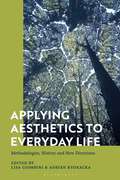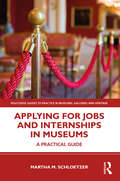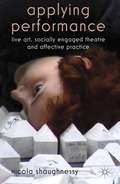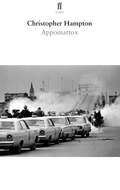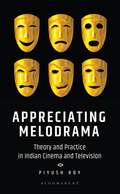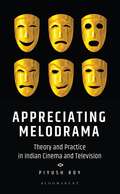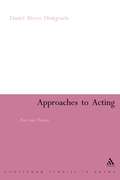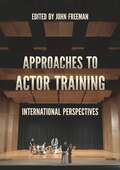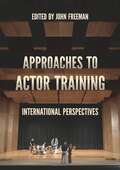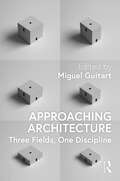- Table View
- List View
Applying Aesthetics to Everyday Life: Methodologies, History and New Directions
by Lisa Giombini and Adrián KvokačkaApplying Aesthetics to Everyday Life surveys current debates in the field of everyday aesthetics, examining its history, methodology and intersections with cognate research areas. Lisa Giombini and Adrián Kvokacka bring together an international team of renowned scholars who are shaping the present and future of the discipline. They demonstrate how the historical origins of everyday aesthetics emerges across the history of Western aesthetic thought, from Renaissance thinkers to the modern German philosophers Baumgarten, Kant and Heidegger. Chapters shed light on the field's methodological underpinnings, tracing its theoretical foundations back to epistemology and ethics and assess the potential of everyday aesthetics as a theoretical tool. They reveal its interdisciplinary nature and how it assists various fields of inquiry, including environmental and urban aesthetics, conservation ethics and the philosophy of art. Through fresh explorations of its origins, background and contemporary developments, this collection advances a new definition of everyday aesthetics and provides a cutting edge reflection on the world we inhabit today.
Applying Aesthetics to Everyday Life: Methodologies, History and New Directions
Applying Aesthetics to Everyday Life surveys current debates in the field of everyday aesthetics, examining its history, methodology and intersections with cognate research areas. Lisa Giombini and Adrián Kvokacka bring together an international team of renowned scholars who are shaping the present and future of the discipline. They demonstrate how the historical origins of everyday aesthetics emerges across the history of Western aesthetic thought, from Renaissance thinkers to the modern German philosophers Baumgarten, Kant and Heidegger. Chapters shed light on the field's methodological underpinnings, tracing its theoretical foundations back to epistemology and ethics and assess the potential of everyday aesthetics as a theoretical tool. They reveal its interdisciplinary nature and how it assists various fields of inquiry, including environmental and urban aesthetics, conservation ethics and the philosophy of art. Through fresh explorations of its origins, background and contemporary developments, this collection advances a new definition of everyday aesthetics and provides a cutting edge reflection on the world we inhabit today.
Applying Color Theory to Digital Media and Visualization
by Theresa-Marie RhyneThis book provides an overview of the application of color theory concepts to digital media and visualization. It highlights specific color concepts like color harmony and shows how to apply the concept with case study examples and usage of actual online and mobile color tools. Color deficiencies are reviewed and discussed are color tools for examining how a specific color map design will look to someone with the deficiency. Other books on color examine artists' use of color, color management, or color science. This book applies fundamental color concepts to digital media and visualization solutions. It is intended for digital media and visualization content creators and developers. Presents Color Theory Concepts that can be applied to digital media and visualization problems over and over again Offers Comprehensive Review of the Historical Progression of Color Models Demonstrates actual case study implementations of color analyses tools Provides overview of Color Theory and Harmony Analytics in terms of online and mobile analysis tools Teaches the color theory language to use in interacting with color management professionals
Applying Color Theory to Digital Media and Visualization
by Theresa-Marie RhyneThis book provides an overview of the application of color theory concepts to digital media and visualization. It highlights specific color concepts like color harmony and shows how to apply the concept with case study examples and usage of actual online and mobile color tools. Color deficiencies are reviewed and discussed are color tools for examining how a specific color map design will look to someone with the deficiency. Other books on color examine artists' use of color, color management, or color science. This book applies fundamental color concepts to digital media and visualization solutions. It is intended for digital media and visualization content creators and developers. Presents Color Theory Concepts that can be applied to digital media and visualization problems over and over again Offers Comprehensive Review of the Historical Progression of Color Models Demonstrates actual case study implementations of color analyses tools Provides overview of Color Theory and Harmony Analytics in terms of online and mobile analysis tools Teaches the color theory language to use in interacting with color management professionals
Applying for Jobs and Internships in Museums: A Practical Guide (Routledge Guides to Practice in Museums, Galleries and Heritage)
by Martha M. SchloetzerApplying for Jobs and Internships in Museums offers a straightforward approach to applying for positions within a museum. Martha M. Schloetzer provides practical advice about the application and interview process that will prepare emerging museum professionals as they approach the profession. From reviewing job and internship postings to developing a solid resume and writing distinctive cover letters, this guide provides practical, sound advice for museum job seekers. Schloetzer integrates the stories of successful and unsuccessful interns and job applicants throughout the book’s narrative, and recognizing the additional challenges faced by non-US nationals, the book also offers information specifically for international students seeking work experience in US museums. The insider information included in Applying for Jobs and Internships in Museums makes it a key resource for both a US and international audience interested in gaining museum experience in the US. It will be of particular interest to college-level and graduate school students, as well as recent graduates. The guide can also serve as a reference in the classroom, helping professors and instructors prepare students for the job search ahead.
Applying for Jobs and Internships in Museums: A Practical Guide (Routledge Guides to Practice in Museums, Galleries and Heritage)
by Martha M. SchloetzerApplying for Jobs and Internships in Museums offers a straightforward approach to applying for positions within a museum. Martha M. Schloetzer provides practical advice about the application and interview process that will prepare emerging museum professionals as they approach the profession. From reviewing job and internship postings to developing a solid resume and writing distinctive cover letters, this guide provides practical, sound advice for museum job seekers. Schloetzer integrates the stories of successful and unsuccessful interns and job applicants throughout the book’s narrative, and recognizing the additional challenges faced by non-US nationals, the book also offers information specifically for international students seeking work experience in US museums. The insider information included in Applying for Jobs and Internships in Museums makes it a key resource for both a US and international audience interested in gaining museum experience in the US. It will be of particular interest to college-level and graduate school students, as well as recent graduates. The guide can also serve as a reference in the classroom, helping professors and instructors prepare students for the job search ahead.
Applying Performance: Live Art, Socially Engaged Theatre and Affective Practice
by N. ShaughnessyThis book draws upon cognitive and affect theory to examine applications of contemporary performance practices in educational, social and community contexts. The writing is situated in the spaces between making and performance, exploring the processes of creating work defined variously as collaborative, participatory and socially engaged.
Applying Physical Ergonomics to Modern Ship Design
by Alexander Arnfinn OlsenThis book combines and summarizes the myriad rules, regulations, guidance, and guidelines that pertain to the human factor element of vessel design and marine operations. With a focus on physical ergonomics, the book is thoroughly researched and draws on the most current Class rules and industry regulations promulgated by the IMO and other organizations. As such, this book serves as a single point of reference for professionals and students involved in human factors and ergonomics at sea.
Applying the ADA: Designing for The 2010 Americans with Disabilities Act Standards for Accessible Design in Multiple Building Types
by Marcela A. RhoadsA guide to real-world applications of The 2010 Americans with Disabilities Act Standards for Accessible Design Applying the ADA helps architects and developers understand better how the rules for eliminating barriers in the built environment apply to everyday life and how to best implement them in the design and construction of a broad variety of buildings and facilities. By showing how The 2010 Americans with Disabilities Act Standards for Accessible Design have been applied in various contexts and building types, this extensively illustrated guide helps readers quickly understand the requirements of the standards and how to apply them to both new construction and renovation. Written by an architect who consults regularly on accessibility issues for design professionals, building owners, and facility managers, this user-friendly guide features 100 photos and 150 drawings that take the guesswork out of applying the standards to real-world projects. Building types covered include: Healthcare and senior living facilities and hospitals College and university facilities Elementary and high schools Hotels and other transient lodging facilities Amusement parks and play areas Historic preservation and remodels Retail and office spaces Applying the ADA is an indispensable resource for architects, interior designers, owners, developers, and facility managers. It is also important reading for students of architecture and interior design.
Applying the ADA: Designing for The 2010 Americans with Disabilities Act Standards for Accessible Design in Multiple Building Types
by Marcela A. RhoadsA guide to real-world applications of The 2010 Americans with Disabilities Act Standards for Accessible Design Applying the ADA helps architects and developers understand better how the rules for eliminating barriers in the built environment apply to everyday life and how to best implement them in the design and construction of a broad variety of buildings and facilities. By showing how The 2010 Americans with Disabilities Act Standards for Accessible Design have been applied in various contexts and building types, this extensively illustrated guide helps readers quickly understand the requirements of the standards and how to apply them to both new construction and renovation. Written by an architect who consults regularly on accessibility issues for design professionals, building owners, and facility managers, this user-friendly guide features 100 photos and 150 drawings that take the guesswork out of applying the standards to real-world projects. Building types covered include: Healthcare and senior living facilities and hospitals College and university facilities Elementary and high schools Hotels and other transient lodging facilities Amusement parks and play areas Historic preservation and remodels Retail and office spaces Applying the ADA is an indispensable resource for architects, interior designers, owners, developers, and facility managers. It is also important reading for students of architecture and interior design.
Applying the Building Code: Step-by-Step Guidance for Design and Building Professionals (Building Codes Illustrated)
by Ronald L. GerenNo other resource—not even the building code—presents the exact code information you need, when you need it at design stage The International Building Code (IBC) is a model building code developed by the International Code Council (ICC). The IBC and its complementary codes provide design and construction professionals with a complete set of comprehensive, coordinated building safety and fire prevention regulations in order to safeguard the public health and general welfare of the occupants of new and existing buildings and structures. Adopted throughout most of the United States and its territories, it is referenced by federal agencies, such as the General Services Administration, National Park Service, Department of State, U.S. Forest Service, and the Department of Defense. For architects and other design and construction professionals, it is particularly important that they understand how to apply the IBC and how code officials view buildings, so that they integrate code-required provisions in the earliest design stages of any project. Applying the IBC, as well as its companion codes, to building design is a process that is uniquely different to that of applying the building code during a planning review. Whereas other guide books explain the IBC in sequential order, from cover to cover, chapter by chapter, and section by section, Applying the Building Code explains the requirements of the IBC as they would apply during the common phases of design: from schematic design through to the preparation of construction documents. This effectively highlights applicable requirements of the building code at the appropriate stage of design based on available information. The book provides a 28-step process that is organized according to the three phases of architectural design: schematic design, design development, and construction documents Each step explains the application of the IBC, as well as other codes and standards referenced by the IBC (i.e. International Fire Code, International Energy Conservation Code, and ANSI A117.1) based on available project information Illustrations and examples are provided throughout that explain the code fundamentals associated with each step A single example project is used throughout the step-by-step process to illustrate how each step is applied and builds upon code and project information obtained through previous steps Guidance is also provided on the International Existing Building Code and how the step-by-step process is applied to projects involving existing buildings The role of the building department and its staff in regard to plan reviews and code enforcement is discussed A detailed code data information template is provided that can help organize code-related information for construction documents
Applying the Building Code: Step-by-Step Guidance for Design and Building Professionals (Building Codes Illustrated)
by Ronald L. GerenNo other resource—not even the building code—presents the exact code information you need, when you need it at design stage The International Building Code (IBC) is a model building code developed by the International Code Council (ICC). The IBC and its complementary codes provide design and construction professionals with a complete set of comprehensive, coordinated building safety and fire prevention regulations in order to safeguard the public health and general welfare of the occupants of new and existing buildings and structures. Adopted throughout most of the United States and its territories, it is referenced by federal agencies, such as the General Services Administration, National Park Service, Department of State, U.S. Forest Service, and the Department of Defense. For architects and other design and construction professionals, it is particularly important that they understand how to apply the IBC and how code officials view buildings, so that they integrate code-required provisions in the earliest design stages of any project. Applying the IBC, as well as its companion codes, to building design is a process that is uniquely different to that of applying the building code during a planning review. Whereas other guide books explain the IBC in sequential order, from cover to cover, chapter by chapter, and section by section, Applying the Building Code explains the requirements of the IBC as they would apply during the common phases of design: from schematic design through to the preparation of construction documents. This effectively highlights applicable requirements of the building code at the appropriate stage of design based on available information. The book provides a 28-step process that is organized according to the three phases of architectural design: schematic design, design development, and construction documents Each step explains the application of the IBC, as well as other codes and standards referenced by the IBC (i.e. International Fire Code, International Energy Conservation Code, and ANSI A117.1) based on available project information Illustrations and examples are provided throughout that explain the code fundamentals associated with each step A single example project is used throughout the step-by-step process to illustrate how each step is applied and builds upon code and project information obtained through previous steps Guidance is also provided on the International Existing Building Code and how the step-by-step process is applied to projects involving existing buildings The role of the building department and its staff in regard to plan reviews and code enforcement is discussed A detailed code data information template is provided that can help organize code-related information for construction documents
Appomattox
by Christopher Hampton4th March, 1865: On the night of his second inauguration, a few weeks before his assassination, Abraham Lincoln meets the veteran black abolitionist Frederick Douglass in the White House to discuss the prospect of extending the vote to black men who have served in the soon to be victorious Union armies.4th March, 1965: In the White House, Lyndon Johnson, anxious to introduce a new Voting Rights Act, is briefed by his sinister and "unfirable" FBI director, J. Edgar Hoover, on the imminent Selma to Montgomery march, led by Dr. Martin Luther King, Jr.. It is a demonstration prompted by a state trooper's murder of the young activist Jimmie Lee Jackson, in Marion, Alabama, following a rally in support of voter registration in Perry County.In his ambitious new play, commissioned by the Guthrie Theater, Minneapolis as the centrepiece of a retrospective of his plays and films, Christopher Hampton traces a line which runs from the last days of a brutal Civil War to the high-water mark of the Civil Rights movement and on, all the way to the present day; and considers the agonisingly slow healing of a wound, universal, but especially deep and painful in America: racism.Appomattox premiered at the McGuire Proscenium Stage in the Guthrie Theater on 5 October, 2012.
Appreciating Melodrama: Theory and Practice in Indian Cinema and Television
by Piyush RoyAppreciating Melodrama: Theory and Practice in Indian Cinema and Television seeks to identify and appreciate the continual influence of the ancient Sanskrit drama treatise, the Natyashastra, and its theory of aesthetics, the rasa theory, on the unique narrative attributes of Indian cinema.This volume of work critically engages with a representative sample of landmark films from 100 years of Indian film history across genres, categories, regions and languages. This is the first time a case study-based rigorous academic review of popular Indian cinema is done using the Indian aesthetic appreciation theory of rasa (affect/emotion). It proposes a theoretical model for film appreciation, especially for content made in the melodramatic genre, and challenges existing First World/Euro-American film criticism canons and notions that privilege cinematic 'realism' over other narrative forms, which will generate passionate debates for and against its propositions in future studies and research on films.This is a valuable academic reference book for students of film and theatre, world cinema and Indian cinema studies, South Asian studies and culture, Indology and the 'Sociology of Cinema' studies. It is a must-have reference text in the curriculum of both practical-oriented acting schools, as well as courses and modules focusing on a theoretical study of cinema, such as film criticism and appreciation, and the history of movies and performance studies.
Appreciating Melodrama: Theory and Practice in Indian Cinema and Television
by Piyush RoyAppreciating Melodrama: Theory and Practice in Indian Cinema and Television seeks to identify and appreciate the continual influence of the ancient Sanskrit drama treatise, the Natyashastra, and its theory of aesthetics, the rasa theory, on the unique narrative attributes of Indian cinema.This volume of work critically engages with a representative sample of landmark films from 100 years of Indian film history across genres, categories, regions and languages. This is the first time a case study-based rigorous academic review of popular Indian cinema is done using the Indian aesthetic appreciation theory of rasa (affect/emotion). It proposes a theoretical model for film appreciation, especially for content made in the melodramatic genre, and challenges existing First World/Euro-American film criticism canons and notions that privilege cinematic 'realism' over other narrative forms, which will generate passionate debates for and against its propositions in future studies and research on films.This is a valuable academic reference book for students of film and theatre, world cinema and Indian cinema studies, South Asian studies and culture, Indology and the 'Sociology of Cinema' studies. It is a must-have reference text in the curriculum of both practical-oriented acting schools, as well as courses and modules focusing on a theoretical study of cinema, such as film criticism and appreciation, and the history of movies and performance studies.
Appreciating the Art of Television: A Philosophical Perspective (Routledge Advances in Television Studies)
by Ted NannicelliContemporary television has been marked by such exceptional programming that it is now common to hear claims that TV has finally become an art. In Appreciating the Art of Television, Nannicelli contends that televisual art is not a recent development, but has in fact existed for a long time. Yet despite the flourishing of two relevant academic subfields—the philosophy of film and television aesthetics—there is little scholarship on television, in general, as an art form. This book aims to provide scholars active in television aesthetics with a critical overview of the relevant philosophical literature, while also giving philosophers of film a particular account of the art of television that will hopefully spur further interest and debate. It offers the first sustained theoretical examination of what is involved in appreciating television as an art and how this bears on the practical business of television scholars, critics, students, and fans—namely the comprehension, interpretation, and evaluation of specific televisual artworks.
Appreciating the Art of Television: A Philosophical Perspective (Routledge Advances in Television Studies)
by Ted NannicelliContemporary television has been marked by such exceptional programming that it is now common to hear claims that TV has finally become an art. In Appreciating the Art of Television, Nannicelli contends that televisual art is not a recent development, but has in fact existed for a long time. Yet despite the flourishing of two relevant academic subfields—the philosophy of film and television aesthetics—there is little scholarship on television, in general, as an art form. This book aims to provide scholars active in television aesthetics with a critical overview of the relevant philosophical literature, while also giving philosophers of film a particular account of the art of television that will hopefully spur further interest and debate. It offers the first sustained theoretical examination of what is involved in appreciating television as an art and how this bears on the practical business of television scholars, critics, students, and fans—namely the comprehension, interpretation, and evaluation of specific televisual artworks.
Approaches to Acting: Past and Present
by Daniel Meyer-DinkgräfeFor centuries the theatre has been one of the major forms of art. How did acting, and its institutionalization in the theatre, begin in the first place? In some cultures complex stories relate the origin of acting and the theatre. And over time, approaches to acting have changed considerably. In the West, until the end of the 19th century, those changes occurred within the realm of acting itself, focusing on the question of whether acting should be 'natural' or 'formal.' Approaches to acting were closely related to the trends in culture at large. Acting became more and more professional and sophisticated as philosophical theories developed and knowledge in the human sciences increased. In the 20th century, the director was established as the most important force in the theater--able to lead actors to pinnacles of their art which they could not have achieved on their own. Approaches to acting in non-Western cultures follow quite different patterns. This book provides a clear overview of different approaches to acting, both historical and contemporary, Western and non-Western, and concludes with a challenge to the future of the art.
Approaches to Actor Training: International Perspectives
by John FreemanThis insightful and practically-focused collection brings together different approaches to actor training from professionals based at universities and conservatoires in the UK, the US and Australia. Exploring the cultural and institutional differences which affect actor training, and analysing developments in the field today, it addresses a range of different approaches, from Stanislavski's System to contemporary immersive theatre. With hands-on focus from some of the world's leading programmes, and attention paid to ethical control, consent and safe practice, this book sees expert tutors exploring pathways to sustainable 21st century careers. Designed for tutors, students and practitioners, Approaches to Actor Training examines what it means to train as an actor, what actors-in-training can expect from their programmes of study and how the road to professional accomplishment is mapped and travelled.
Approaches to Actor Training: International Perspectives
by John FreemanThis insightful and practically-focused collection brings together different approaches to actor training from professionals based at universities and conservatoires in the UK, the US and Australia. Exploring the cultural and institutional differences which affect actor training, and analysing developments in the field today, it addresses a range of different approaches, from Stanislavski's System to contemporary immersive theatre. With hands-on focus from some of the world's leading programmes, and attention paid to ethical control, consent and safe practice, this book sees expert tutors exploring pathways to sustainable 21st century careers. Designed for tutors, students and practitioners, Approaches to Actor Training examines what it means to train as an actor, what actors-in-training can expect from their programmes of study and how the road to professional accomplishment is mapped and travelled.
Approaches to Byzantine Architecture and its Decoration: Studies in Honor of Slobodan Curcic
by Mark J. Johnson Amy PapalexandrouThe fourteen essays in this collection demonstrate a wide variety of approaches to the study of Byzantine architecture and its decoration, a reflection of both newer trends and traditional scholarship in the field. The variety is also a reflection of Professor Curcic’s wide interests, which he shares with his students. These include the analysis of recent archaeological discoveries; recovery of lost monuments through archival research and onsite examination of material remains; reconsidering traditional typological approaches often ignored in current scholarship; fresh interpretations of architectural features and designs; contextualization of monuments within the landscape; tracing historiographic trends; and mining neglected written sources for motives of patronage. The papers also range broadly in terms of chronology and geography, from the Early Christian through the post-Byzantine period and from Italy to Armenia. Three papers examine Early Christian monuments, and of these two expand the inquiry into their architectural afterlives. Others discuss later monuments in Byzantine territory and monuments in territories related to Byzantium such as Serbia, Armenia, and Norman Italy. No Orthodox church being complete without interior decoration, two papers discuss issues connected to frescoes in late medieval Balkan churches. Finally, one study investigates the continued influence of Byzantine palace architecture long after the fall of Constantinople.
Approaches to Byzantine Architecture and its Decoration: Studies in Honor of Slobodan Curcic
by Mark J. Johnson Amy PapalexandrouThe fourteen essays in this collection demonstrate a wide variety of approaches to the study of Byzantine architecture and its decoration, a reflection of both newer trends and traditional scholarship in the field. The variety is also a reflection of Professor Curcic’s wide interests, which he shares with his students. These include the analysis of recent archaeological discoveries; recovery of lost monuments through archival research and onsite examination of material remains; reconsidering traditional typological approaches often ignored in current scholarship; fresh interpretations of architectural features and designs; contextualization of monuments within the landscape; tracing historiographic trends; and mining neglected written sources for motives of patronage. The papers also range broadly in terms of chronology and geography, from the Early Christian through the post-Byzantine period and from Italy to Armenia. Three papers examine Early Christian monuments, and of these two expand the inquiry into their architectural afterlives. Others discuss later monuments in Byzantine territory and monuments in territories related to Byzantium such as Serbia, Armenia, and Norman Italy. No Orthodox church being complete without interior decoration, two papers discuss issues connected to frescoes in late medieval Balkan churches. Finally, one study investigates the continued influence of Byzantine palace architecture long after the fall of Constantinople.
Approaches to Probabilistic Model Learning for Mobile Manipulation Robots (Springer Tracts in Advanced Robotics #89)
by Jürgen SturmThis book presents techniques that enable mobile manipulation robots to autonomously adapt to new situations. Covers kinematic modeling and learning; self-calibration; tactile sensing and object recognition; imitation learning and programming by demonstration.
Approaching Architecture: Three Fields, One Discipline
by Miguel GuitartThe study of the architectural discipline suffers from an increasing disconnect between its teaching and its professional practice. In this edited collection, 18 architectural voices address this disconnect by reflecting on the ways in which they exercise the architectural discipline in three ways: research, teaching, and practice. This book argues that the totality of activities encompassed by the architectural profession can be best fulfilled when reconsidering the critical interactions between these three fields in the everyday exercise of the profession. Split into three parts, "Architecture as Research," Architecture as Pedagogy," and "Architecture as Practice," each section focuses on one of these three dimensions while establishing continuity with the other two. In doing so, the book not only favors a more fulfilling interaction between academia and the profession but also reinforces the implementation of design theory and research in everyday teaching and practice. The contributions come from 18 teams of architects operating from geographically diverse locations, including Pezo von Ellrichshausen in Chile, Kengo Kuma & Associates in Japan, Barclay & Crousse in Peru, Shift in Iran, Heinrich Wolff in South Africa, and People’s Architecture Office in China, opening the design conversation to larger contexts and framing continuity and inclusion in time. Written for students, instructors, and practitioners alike, the inspiring reflections in this volume encourage readers to grow as architects and play an instrumental role in transforming the built environment.
Approaching Architecture: Three Fields, One Discipline
by Miguel GuitartThe study of the architectural discipline suffers from an increasing disconnect between its teaching and its professional practice. In this edited collection, 18 architectural voices address this disconnect by reflecting on the ways in which they exercise the architectural discipline in three ways: research, teaching, and practice. This book argues that the totality of activities encompassed by the architectural profession can be best fulfilled when reconsidering the critical interactions between these three fields in the everyday exercise of the profession. Split into three parts, "Architecture as Research," Architecture as Pedagogy," and "Architecture as Practice," each section focuses on one of these three dimensions while establishing continuity with the other two. In doing so, the book not only favors a more fulfilling interaction between academia and the profession but also reinforces the implementation of design theory and research in everyday teaching and practice. The contributions come from 18 teams of architects operating from geographically diverse locations, including Pezo von Ellrichshausen in Chile, Kengo Kuma & Associates in Japan, Barclay & Crousse in Peru, Shift in Iran, Heinrich Wolff in South Africa, and People’s Architecture Office in China, opening the design conversation to larger contexts and framing continuity and inclusion in time. Written for students, instructors, and practitioners alike, the inspiring reflections in this volume encourage readers to grow as architects and play an instrumental role in transforming the built environment.

